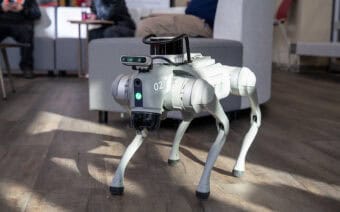
January 6, 2025
NORTH CENTRAL WISCONSIN – Israel Squires, CEO and co-founder of Midpoint Consulting, said a recent McKinsey & Company survey on the state of artificial intelligence (AI) said it best: “If 2023 was the year the world discovered generative AI, 2024 is the year organizations truly began using and deriving business value from the new technology.”
That said, Squires said it’s only a slice of the business populace that’s embracing AI.
And the even smaller sliver using it for two or more business functions, he said, is just that – a small percent – even as AI adoption is on the rise.
Squires said it’s an example of what businesses nationally are thinking: “I want to embrace AI, but how do I do so responsibly, ethically and optimally?”
Providing tailored answers to that very question, and more, he said, is at the core of the Central Wisconsin AI Center (CWAIC) that launched Nov. 1, 2024.
Squires said the center is positioned as the intersection of innovation, collaboration and opportunity in preparing Central Wisconsin for an AI-driven future.
He said it taps into an abundance of AI expertise and application from Midpoint Consulting, a business consultancy with decades of AI experience; alongside three post-secondary educational institutions – Northcentral Technical College (NTC), the University of Wisconsin-Stout (UW-Stout) and the University of Wisconsin-Stevens Point (UWSP) – and the Greater Wausau Chamber of Commerce, to tackle business opportunities and needs relative to AI adoption.
Squires said the center is expected to help hundreds of businesses in the region get started in their AI adoption journey and, in turn, train thousands of workers in the foundational building blocks of AI adoption.
Using proprietary, AI-driven assessments at the front end, Squires said the center then taps its partners to provide the right workforce training programs, industry-specific AI solutions, cutting-edge AI resources, personalized support and networking opportunities with others in the same shoes.
He said its primary goal is to provide the resources and support necessary to ignite AI growth in every sector of the Central Wisconsin region.
Center origins
It’s a journey that Squires said has been two years in the making.
Midpoint Consulting, he said, started conversations with Greenheck Group and the Greater Wausau Chamber of Commerce about two years ago regarding the gaps in AI adoption and the resulting workforce training needed in response.
And simultaneously as businesses voiced a need for all things AI learning, he said the cry went out for higher education to address the AI knowledge gap.
All roads convened, Squires said, with the establishment of the membership-based CWAIC.
“(At Midpoint), we had the AI software, but we needed experts and business leadership in the region to come together with a mechanism to ‘answer the call’ of meeting the market where it was,” he said. “I don’t know that there is anything like this center in the country.”

Squires said an increased number of Central Wisconsin businesses are realizing they need to invest in AI or risk losing market share – with many admitting they aren’t sure how to invest.
For those who are unsure, he said, the center delivers comprehensive learning on how to invest in AI.
He said it is a hub of both AI expertise and application with the tools and knowledge that businesses, students and the workforce need to thrive in the era of AI.
Its foundational course offerings include AI 101, Prompting Techniques, Security and Compliance and AI Adoption for Businesses.
What the numbers say
AI is an area of explosive growth – with Marketsandmarkets anticipating the market size to grow from an estimated $214 billion in revenue in 2024 to $1,339 billion by 2030.
Squires said he sees the opportunity for impact as two-fold.
First, the business’s training software will allow for a tailored focus on specific use cases, all of which will be data-driven decisions.
“It starts with blocking and tackling work,” he said. “We know that 70% of workers in business, regardless of size, are using free ChatGPT and likely uploading company data or client data into open AI. This is not a good practice, and so the first box to check is to make sure we’re helping businesses not do that.”
Second, Squires said it helps businesses make thoughtful, intentional and fiscally responsible investments in AI.
“What we’ve seen in the past few years is that even middle market companies have created chatbots and chased shiny things, versus taking a pragmatic approach (to AI),” he said. “We want to look at and prioritize use cases to determine how they can use AI effectively.”
Squires said it’s about starting small and being fiscally responsible.
“The imagery we use is that we will enable a company to ‘turn on the electricity’ – use AI – at some point,” he said.
Squires said the center’s services are the outgrowth of data-driven AI assessments offered to center members on the front end.
He said that’s followed by AI training and upskilling for businesses and workers through in-person and online programs provided by the center, as well as its partners.
Squires said those are further complemented by the creation of innovative ecosystems within each business, identifying AI use cases, selecting the right AI tools and providing the necessary training.
Within three years, Squires said the center aims to engage with more than 100,000 workers and more than 300 businesses in the region through digital AI assessments, digital training, in-person training, in-person workshops, in-person seminars and other programs.
And that, he said, is where any or all of the post-secondary educational institution partners come in.
“When a business wants to send 10 finance folks to get a certificate in AI or help them optimize new tools, we work with our educational partners to deliver that,” he said. “There’s that circular mission we’re trying to execute so that the institutions can answer the exact calls of business.”
AI training provider, beneficiary
The post-secondary educational institutions that stepped up to the plate as partners in the center, Squires said, each do so with distinct offerings, strengths, expertise and opportunities.
NTC became a partner and the first client of the center simultaneously, which NTC President Jeannie Worden said was a natural outgrowth of its existing initiatives, alignment with the college’s five-year strategic plan and ongoing work to incorporate AI into curriculum.
“The work in AI really aligns with our strategic plan, and when the center became an opportunity, it just made sense to be a partner with it,” she said. “We are a leader in AI and a leader in the ecosystem to help our students and our employers.”
During her 29-year tenure at NTC, Worden said the closest thing she can liken to the opportunities and potential pitfalls of AI is the introduction of the internet.

“I think about AI in terms of how revolutionary the internet was, and I put AI in the same ballpark as that,” she said.
The educational institution’s embrace of the new technology, Worden said, can be seen in its faculty’s commitment to research and incorporation of AI into each curriculum as appropriate.
Worden said the college’s implementation plan is focused on three areas: having structure and resources in place to serve students pursuing associate degrees, businesses tapping continuing education offerings and adopting AI further as an employer itself.
“We are working to make sure our students graduate with that leading-edge experience as they go out into the workforce,” she said. “It’s what our employers expect of us, and we are proud to train for what’s important to our community.”
In particular, Worden said NTC brings expertise in serving healthcare, agriculture and manufacturing industries, particularly of great interest to CWAIC.
“We’re coming at it from all three areas and have hired the staffing and invested in the technology to support it,” she said.
Worden said she credits long-standing, collaborative relationships with the chamber and their fellow higher educational institutions as being integral to the center’s ability to work.
“I don’t see them as competition – I see them as partners in ensuring we are training a qualified workforce,” she said.
CWAIC’s physical location is on the NTC campus, which Worden said offers high-tech conference room space, office space and training space for both in-person and virtual learning for CWAIC members.
“We’re excited to partner with UW-Stout and UWSP in building a culture of responsible AI use that drives productivity, sustainability and innovation in central Wisconsin,” she said.
Teachers lead the way
At UWSP – another of CWAIC’s educational partners – Jenny Resch, executive director of economic engagement and strategic partnerships, said a key focal point of AI-focused effort on campus is with its School of Education and the K-12 teachers the program graduates and sends into schools nationwide.
“Our K-12 education program is phenomenal, a nationally known program, and we’re graduating teachers who are going to immediately engage in the AI landscape in their schools,” she said. “We acknowledge that if we’re going to advance the strengths of the Central Wisconsin workforce, employees – including teachers – need to show up with the tools, knowledge and resourcefulness to navigate the AI world.”
Resch said the same mindset applies throughout the campuses’ other programs, such as the Sentry School of Business’ adoption of AI for use with financial industry tools.
The university, she said, is walking the walk, guided by an AI implementation committee with representation from across campus benefiting from each others’ research and learnings.
In addition, Resch said faculty have access to the Center for Inclusive Teaching and Learning to help adapt and change coursework and the classroom in response to AI.

“For example, it includes recognizing students may integrate AI with assignments, using it to their advantage, but that requires us to advance the curriculum and evolve our teaching to enhance additional learning,” she said. “AI permeates every corner of the university.”
In addition, Resch said the university embraced AI by planning and hosting an AI conference for business and industry in early 2024 – which focused on manufacturing and health care – and will host its second annual AI Innovations Conference in February 2025.
The 2025 conference, she said, will host industry tracks including education.
Resch said NTC is involved in helping to plan the 2025 event because of both geographic and mindset synergy, while simultaneously offering an opportunity to highlight CWAIC’s work and the educational institutions’ strengths to train the workforce.
Resch said the knowledge and training of CWAIC extends not only to graduates but businesses tapping into the university’s continuing education and outreach offerings.
UWSP frequently works with business and industry to customize specialized training, she said, whether it’s leadership development, wellness coaching or AI.
Resch said UWSP will answer the call to provide AI-focused training and professional development to businesses through the CWAIC.
“What we’ve been working on is now integrated into the work of the center, meeting organizations where they are, as everyone is at a different point of integrating AI into their company,” she said. “Recognizing where they are – and not telling them where they need to be – is critical to the success of the center.”
Manufacturing first for this polytechnic university
UW-Stout’s participation as a partner in the CWAIC, Seth Hudson, executive director, corporate relations and economic engagement, said was an easy “yes” for the state’s only polytechnic university whose approach involves hands-on learning and strong working relationships with industry and community stakeholders.
“CWAIC allows us to further bring that approach to companies seeking AI resources and assistance, especially manufacturers,” he said.
Hudson said AI is something UW-Stout is embracing across campus – from having a designated staff member to coordinate how AI is being incorporated campuswide, to the AI Club which is fast approaching 50 members.
“We are integrating AI mindfully into everything across campus,” he said. “We’re approaching it like when the internet came out. It’s going to touch all these areas in different ways, and it’s important to have a common basis of understanding throughout all programming.”
Hudson said it’s also an integral part of the university’s existing work with small- and medium-sized manufacturers – one of Wisconsin’s leading workforce sectors of more than 8,900 companies, employing more than 490,000 workers.
One of UW-Stout’s manufacturing center offerings includes the late summer launch of the Center for Advanced Manufacturing and Artificial Intelligence (CAM-AI), which Hudson said was created to leverage the university’s expertise in solving technical issues and conducting research to support private industry.
“That center’s role is to use faculty, graduate students and some undergraduate students to work with industry to address issues and challenges on the manufacturing floor and throughout the company, including advanced manufacturing and AI,” he said.
Hudson said CAM-AI is tied to UW-Stout’s Manufacturing Outreach Center, one of two Wisconsin centers affiliated with the National Institute of Standards and Technology/Manufacturing Extension Partnership.
The two-decades-old program, he said, offers comprehensive solutions through consulting, training and workforce development for manufacturers in particular.
Hudson said it leverages the university’s industry experience, tech savviness and teamwork to improve manufacturers’ processes, grow their businesses, enrich their people and develop products.
Together, he said the CAM-AI and UW-Stout Manufacturing Outreach Center deliver consulting, training and workforce development for clientele.
Hudson said those two programs’ capabilities are now interwoven with CWAIC, both serving as a “feeder” to CWAIC, as well as drawing additional training opportunities to UW-Stout from businesses that start by knocking on CWAIC’s doors.

In doing so, Hudson said UW-Stout’s expertise in manufacturing and AI solutions and support can reach businesses beyond the 33 Northwest Wisconsin counties with which they typically work.
“Companies (in these UW-Stout programs) that say, ‘We need to figure out how to implement AI on our floor, or in our supply chain,’ can come through our centers where we can get an understanding of what they want to focus on,” he said. “If it’s AI, the collective group at (CWAIC) can look at the (intake survey) and say, ‘Here are the opportunities for back office accountants on how to use AI with Excel’ or ‘how to incorporate AI into an assembly line.’”
Hudson said it’s really a matter of synergy and compounding the impact any one of the entities can have for businesses seeking AI knowledge and training.
Depending on the needs revealed, Hudson said any one or more of the educational institutions (UW-Stout, UWSP and NTC) may step up to deliver training and education for a given CWAIC member.
“Any one of us could deliver the training depending on capacity, existing relationships and the right offerings,” he said. “We can collectively figure it out to find the best fit.”
Hudson said he is excited to see what CWAIC’s intake survey reveals for companies they will work with, even manufacturers that have been working with any of UW-Stout’s programs for years.
“It’s a great way to start and it will guide the entity or individual on where to go next (in their AI journey) based on data,” he said. “That intake process narrows the focus and provides a better understanding of what a business’s needs are and how we, across CWAIC, can collectively come back to them with solutions.”
Case in point: Greenheck Group
Scott Graf, chief manufacturing officer of Schofield-headquartered Greenheck Group, said the company sees the CWAIC as a natural next step to its existing partnerships with higher education.
Graf said the HVAC equipment manufacturer sees many applicable opportunities for businesses and the community at large.
“We are only just beginning to engage in the AI Center, but see many applicable opportunities,” he said. “AI is already a vital tool in our personal lives – think of how you use Google, GPS, Amazon, etc. It has many similar opportunities in business, allowing us to access information, analyze data and make better decisions.”

Graf said he anticipates Greenheck will embrace AI for multiple benefits – including:
- Improving office efficiency by quickly drafting communications, presentations and emails
- Creating better sales and finance forecasts to more accurately plan labor and material requirements
- Enhancing quality, safety and efficiency by monitoring manufacturing equipment for potential failures before they occur
- Improving product design and model/predict the performance of the company’s fans for better energy efficiency.
Collectively, Graf said applying AI will reduce redundant and/or repetitive tasks, freeing up time for more meaningful work at Greenheck.
“And that means better and more rewarding jobs,” she said.
Business case for AI advancement, training
Dave Eckmann, president and CEO of the Greater Wausau Chamber of Commerce, said of its 800 members, 450-500 are small- and medium-sized enterprises.
Eckmann said their level of knowledge and integration of AI and innovation of all kinds can differ significantly from their larger business peers.
“The economic development plan we created a few years ago calls for action in placemaking, talent and innovation,” he said. “It all fits together, and there is a lot of work being done on placemaking and the talent pipeline in the community. But we needed to do more for innovation. That requires small, medium and large companies to access technology including (Industry) 5.0 technologies, and AI is part of that.”
Eckmann said a conversation with Squires about the importance of advancing technology and Industry 5.0 prompted work with business and industry partners to understand the current state of AI adoption.
Conversations, Eckmann said, revealed it was incumbent on the chamber to play a role.
“Our members need to always be looking at innovation and change to be more competitive in this changing economic environment,” he said.
Eckmann said he recognizes that if Central Wisconsin businesses don’t integrate AI and other innovations into their businesses, the competition will move ahead of them.
Supporting the center, he said, is well aligned with other, complementary work the chamber is doing toward embracing more of a culture of innovation.
Eckmann said that includes work during the 18 months to create a program called Powering Innovation, an innovation ecosystem, that will launch soon.

“When you look at Central Wisconsin, we don’t have that ecosystem here,” he said. “We are separated from Green Bay by 90 miles on one side, and Eau Claire and the Twin Cities on the other – sitting in the middle of Wisconsin and (we) don’t have the density of the Green Bay to Milwaukee corridor, Milwaukee to Madison or Madison to the Cities. We are isolated here, which is why we are creating our own innovation ecosystem.”
Eckmann said the ecosystem is built on three pillars: a digital toolbox, awareness built by bringing the toolbox into the region through content planning and storytelling of ecosystem partners’ successes and failures.
The digital toolbox, he said, is a significant aspect of the chamber’s website redevelopment to showcase innovation resources and expertise as well as programming, all collected and presented in a single place.
Eckmann said it’s well-timed as a complement to CWAIC, delivering small business resources for AI and further directing chamber members to CWAIC within the toolbox.
He said it also features a compilation of the services and resources from universities, technical colleges, small business development centers, innovation centers of excellence, funding sources and more.
Bringing all those together, Eckmann said, will allow the business community to easily access points of service “versus having to hunt down each service.”
“It’s a new digital resource and center of excellence to serve business, industry and entrepreneurs,” he said.
Pointing more businesses to CWAIC, Powering Innovation and the chamber, Eckmann said, can further businesses’ abilities to embrace the technology and innovation opportunities inherent in AI.
“At the heart of every business enterprise is its people – the workforce,” he said. “CWAIC will ensure companies and working professionals have access to AI tools that will allow for growth and prosperity.”
For further details on the CWAIC, visit centralwiaicenter.com.
 A new standard in electric refuse and recycling collection
A new standard in electric refuse and recycling collection Horsing around is a way of life for two sisters in De Pere
Horsing around is a way of life for two sisters in De Pere







